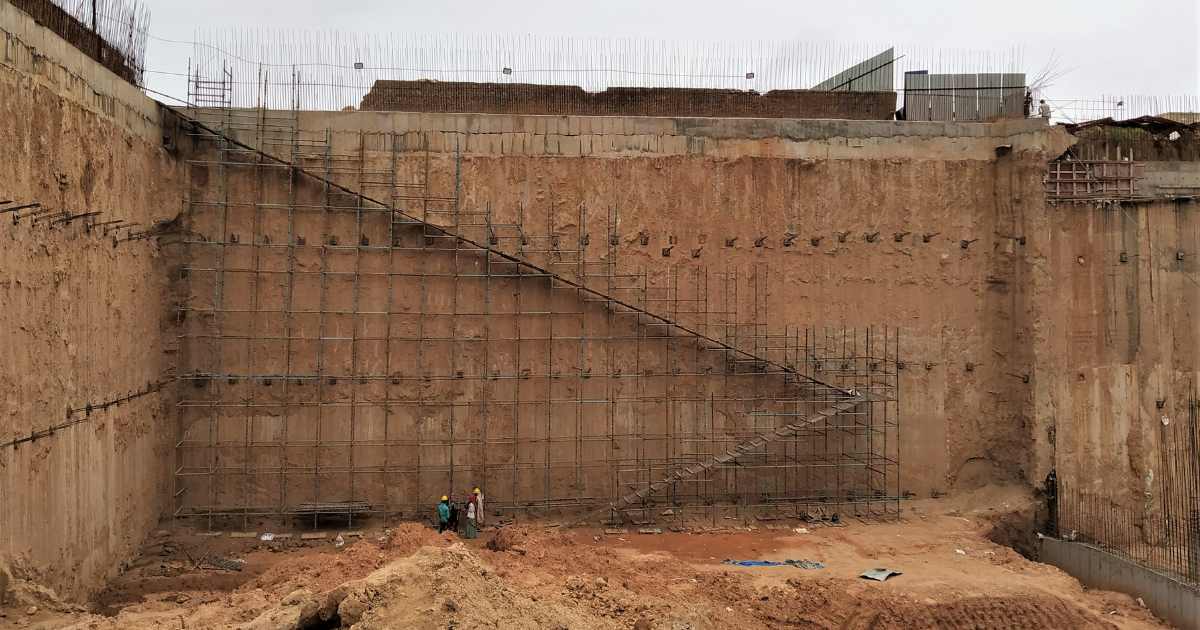When it comes to civil engineering projects involving underground structures or terrain stabilization, two commonly employed methods are Diaphragm Wall vs Retaining Wall construction. While both serve the purpose of retaining soil and supporting vertical or near-vertical grade changes, they differ significantly in their design, construction techniques, and applications. In this comprehensive comparison, we delve into the distinctive features of Diaphragm Wall and Retaining Wall systems, highlighting their advantages, limitations, and suitability for various projects.
Diaphragm Wall vs Retaining Wall : Definition and Design
Diaphragm Wall: Diaphragm walls, also known as slurry walls, are constructed by excavating a trench, usually using specialized machinery, and then filling it with a bentonite slurry to prevent collapse. Reinforcement bars are then inserted, followed by the pouring of concrete. The resulting structure is a thick vertical wall that can withstand high lateral pressures, making it ideal for deep excavation projects such as basements, underground parking lots, and subway stations.
Retaining Wall: Retaining walls are structures designed to restrain soil and prevent erosion on slopes. They can be constructed using various materials such as concrete, masonry, timber, or even reinforced soil. The design of retaining walls depends on factors such as soil type, water pressure, and desired aesthetics. Retaining walls can be gravity walls, cantilever walls, anchored walls, or reinforced soil walls, each with its unique construction method and application.
Diaphragm Wall vs Retaining Wall : Construction Techniques
Diaphragm Wall: The construction of diaphragm walls involves specialized equipment and skilled labor. Excavation is typically carried out using grab buckets or clamshells attached to crawler cranes. The trench is stabilized with bentonite slurry to prevent collapse during excavation. Once the trench is excavated to the required depth, reinforcement cages are lowered and concrete is poured using tremie pipes to displace the slurry. The process is repeated in sections until the entire wall is completed.
Retaining Wall: Retaining walls can be constructed using various techniques depending on the chosen material and design. Gravity walls rely on their weight to resist pressure from behind, while cantilever walls use a base slab and an upright stem to support the soil. Anchored walls employ tiebacks or anchors to provide additional lateral support. Construction methods may include poured-in-place concrete, precast concrete panels, stacked masonry blocks, or gabion baskets filled with stone. The choice of construction method depends on factors such as cost, site conditions, and aesthetic requirements.
Diaphragm Wall vs Retaining Wall : Advantages and Limitations
Diaphragm Wall:
- Advantages:
- Excellent structural integrity and load-bearing capacity.
- Suitable for deep excavations in urban areas with limited space.
- Provides a watertight barrier, making it ideal for underground structures.
- Limitations:
- High construction costs due to specialized equipment and labor.
- Time-consuming process compared to other retaining wall methods.
- Limited flexibility in design modifications once construction has commenced.
Retaining Wall:
- Advantages:
- Versatile design options to suit different site conditions and aesthetic preferences.
- Can be constructed using a variety of materials, allowing for cost-effective solutions.
- Faster construction compared to diaphragm walls, especially for smaller-scale projects.
- Limitations:
- May require additional drainage systems to prevent water buildup behind the wall.
- Limited height and load-bearing capacity compared to diaphragm walls.
- Maintenance requirements vary depending on the material used, such as repointing for masonry walls or corrosion protection for steel-reinforced walls.
Diaphragm Wall vs Retaining Wall : Applications
Diaphragm Wall: Diaphragm walls are commonly used in:
- Deep basement construction for high-rise buildings.
- Underground parking garages and transportation tunnels.
- Waterfront structures such as quay walls and flood protection barriers.
Retaining Wall: Retaining walls find applications in:
- Residential landscaping to create terraced gardens or level uneven terrain.
- Highway and railway embankments to prevent soil erosion and slope instability.
- Coastal protection structures to mitigate the effects of erosion and storm surges.
Conclusion:
In conclusion, while both Diaphragm Wall vs Retaining Wall systems serve the purpose of retaining soil and supporting vertical grade changes, they differ in construction techniques, design flexibility, and applications. Diaphragm walls offer superior structural integrity and are well-suited for deep excavations in urban environments, while retaining walls provide versatile design options and are suitable for a wide range of projects. Ultimately, the choice between the two depends on factors such as site conditions, project requirements, and budget constraints, with each offering its unique advantages and limitations.
Hindustan Diaphragm Walls stand as a testament to innovation and efficiency in civil engineering. With their robust design, precise construction techniques, and adaptability to challenging urban environments, Hindustan D-Walls offer unparalleled solutions for deep excavation projects. Whether it’s the construction of high-rise buildings, underground parking facilities, or waterfront structures, Hindustan D-Walls deliver exceptional performance, durability, and peace of mind to engineers and developers alike. Embracing Hindustan Diaphragm Walls signifies embracing excellence in construction, ensuring the success and longevity of projects for generations to come.







